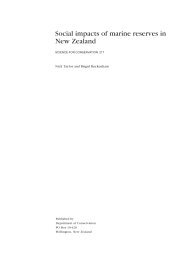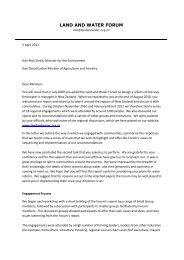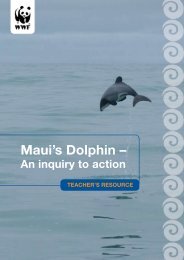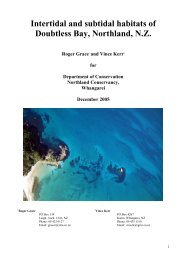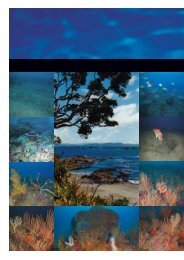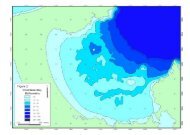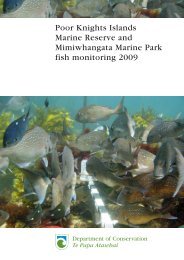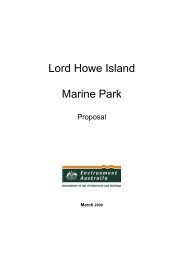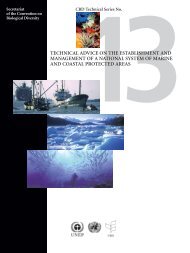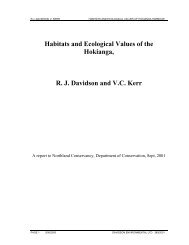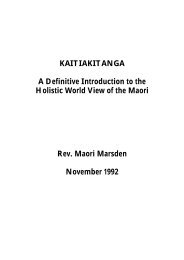WWF Shining a spotlight on the biodiversity of ... - MarineNZ.org.nz
WWF Shining a spotlight on the biodiversity of ... - MarineNZ.org.nz
WWF Shining a spotlight on the biodiversity of ... - MarineNZ.org.nz
You also want an ePaper? Increase the reach of your titles
YUMPU automatically turns print PDFs into web optimized ePapers that Google loves.
Chatham Islands<br />
Map ID number:<br />
19b<br />
Locati<strong>on</strong>: The Chatham<br />
Islands are at <strong>the</strong> eastern<br />
end <strong>of</strong> <strong>the</strong> Chatham Rise and<br />
are an intermixing z<strong>on</strong>e <strong>of</strong><br />
subantarctic and subtropical<br />
elements. They are <strong>the</strong> most<br />
easterly island group in <strong>the</strong><br />
New Zealand marine z<strong>on</strong>e.<br />
Approximate area: Not<br />
delineated by benthic group<br />
during <strong>the</strong> workshop.<br />
Descripti<strong>on</strong> <strong>of</strong> area:<br />
The Chatham Islands has a complex marine<br />
habitat <strong>of</strong> intermixing currents and eddies<br />
associated with shelf edges and subterranean<br />
features.<br />
Biological attributes:<br />
The islands have a good diversity <strong>of</strong><br />
seaweeds and crustose coralline algae<br />
species. There is reas<strong>on</strong>ably high endemism<br />
<strong>of</strong> ascidians, molluscs, and seaweeds.<br />
Criteria applied:<br />
Endemism; species richness; representati<strong>on</strong>;<br />
extremities <strong>of</strong> range; meeting ground; habitat<br />
complexity/diversity.<br />
Status and management:<br />
The low human impact <strong>on</strong> some shores<br />
allows protecti<strong>on</strong> <strong>of</strong> crustose coralline<br />
habitat and delicate fossil sp<strong>on</strong>ges.<br />
State <strong>of</strong> informati<strong>on</strong>:<br />
Not recorded during <strong>the</strong> workshop<br />
References and fur<strong>the</strong>r reading:<br />
Hay (1989), Knox (1957), Nels<strong>on</strong> et al.<br />
(1991), Schiel et al. (1995), Schiel and<br />
Hickford (2001).<br />
Chatham Island<br />
©2004 DOC, Te Papa Atawhai<br />
Fiordland<br />
Map ID number:<br />
20<br />
Locati<strong>on</strong>: Southwest regi<strong>on</strong> <strong>of</strong><br />
<strong>the</strong> South Island<br />
Approximate area: 5,196km 2<br />
Descripti<strong>on</strong> <strong>of</strong> area:<br />
This area c<strong>on</strong>tains New Zealand’s <strong>on</strong>ly<br />
fiords. There are a variety <strong>of</strong> physical<br />
gradients am<strong>on</strong>g <strong>the</strong>m. Notable features <strong>of</strong><br />
<strong>the</strong> area include a very narrow c<strong>on</strong>tinental<br />
shelf and a near-permanent, low-salinity<br />
surface layer within <strong>the</strong> fiords.<br />
Biological attributes:<br />
Fiordland is a special marine envir<strong>on</strong>ment in<br />
that species normally found in deep water,<br />
such as sea pens, glass sp<strong>on</strong>ges, and certain<br />
corals, emerge in shallow water. The area<br />
has high cnidarian faunal diversity including<br />
habitat-forming black corals (Antipatharia)<br />
and red corals (Stylasteridae).<br />
Bryozoan thickets (Ade<strong>on</strong>ellopsis) are found<br />
<strong>on</strong> entrance sills <strong>of</strong> <strong>the</strong> fiords. Fiordland also<br />
has high algal diversity, a fact that has been<br />
largely overlooked until recently. Crustose<br />
coralline algae are important in <strong>the</strong> rock wall<br />
communities.<br />
Criteria applied:<br />
Species diversity; special c<strong>on</strong>diti<strong>on</strong>s and<br />
specialised <strong>org</strong>anisms.<br />
Status and management:<br />
There are two marine reserves, <strong>on</strong>e in<br />
Milford Sound and <strong>the</strong> o<strong>the</strong>r in Doubtful<br />
Sound. A comprehensive management<br />
strategy has been developed to protect <strong>the</strong><br />
fisheries resources and marine envir<strong>on</strong>ment,<br />
but this has yet to be formally approved in<br />
legislati<strong>on</strong>.<br />
State <strong>of</strong> informati<strong>on</strong>:<br />
Large number <strong>of</strong> scientific papers. University<br />
<strong>of</strong> Otago holds a living bibliography <strong>of</strong><br />
studies.<br />
References and fur<strong>the</strong>r reading:<br />
Glasby (1978), Grange (1985, 1988, 1990,<br />
1991b), Grange and Goldberg (1992, 1993a,<br />
1993b), Grange and Singlet<strong>on</strong> (1988),<br />
Nels<strong>on</strong> et al. (2002), Schiel and Hickford<br />
(2001), Skerman (1964), Wing (2003).<br />
Red coral, Fiordland<br />
BIODIVERSITY – NEW ZEALAND’S MARINE ECOREGION ■ 61<br />
©2004 DOC, Te Papa Atawhai





